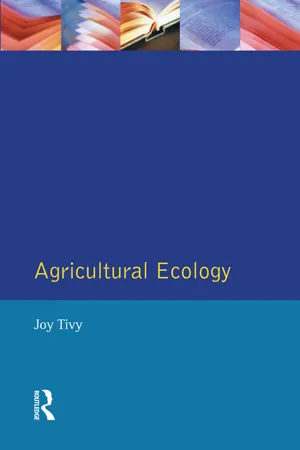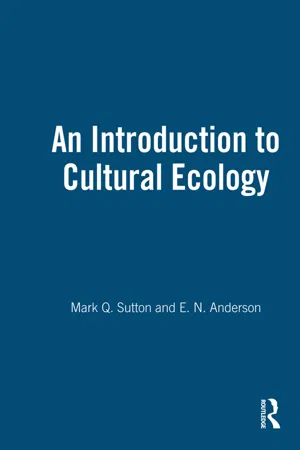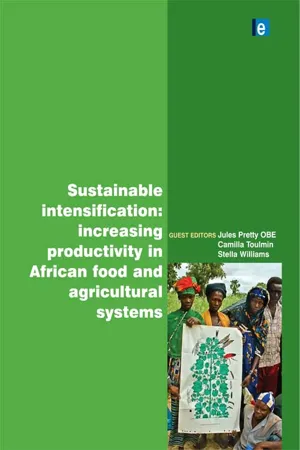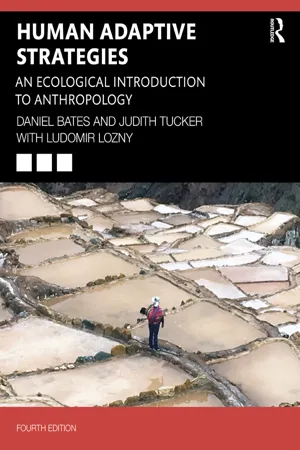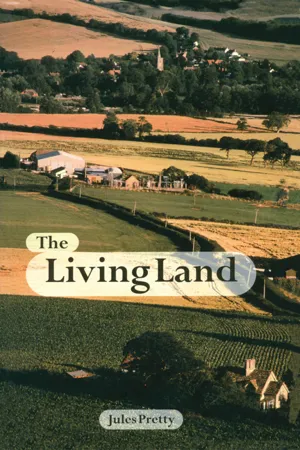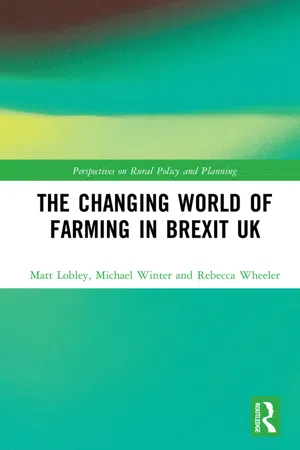Geography
Intensive Farming
Intensive farming refers to a method of agricultural production that aims to maximize yields from a given piece of land through the use of high inputs such as labor, capital, and technology. This approach often involves high stocking densities of livestock and the use of chemical fertilizers and pesticides. Intensive farming is characterized by its high productivity but can also lead to environmental and social concerns.
Written by Perlego with AI-assistance
Related key terms
Related key terms
1 of 4
Related key terms
1 of 3
7 Key excerpts on "Intensive Farming"
- eBook - ePub
- Joy Tivy(Author)
- 2014(Publication Date)
- Routledge(Publisher)
Chapter 14 Intensive agriculture Modern intensive agriculture is characterized above all by the use of the most sophisticated technological methods of farming. It involves high levels of capital expenditure or inputs in order to achieve as high an output per unit ofland area and/ or of livestock with the maximum efficiency possible. As well as fixed capital, and investment in land, buildings, livestock and machinery, Intensive Farming incurs large annual production costs. These include, on the one hand, those of supplying direct energy – in the form of human and/or animal labour, fossil fuels and electricity-necessary to undertake farm work; and, on the other, those of supplying indirect energy, represented by fertilizers, water, herbicides, pesticides, seeds and a wide range of other chemical products necessary to obtain high levels of crop and/or livestock production. Slesser (1975) has used energy density or the input of total energy (direct and indirect) equivalents ‘at the farm gate’ per hectare of farmland as a means of expressing relative intensity of agriculture (see Table 14.1). The expenditure on the individual inputs varies with the type of farming (Fig. 14.1). Temperate soft fruits (raspberries, strawberries etc.) are still very labour-intensive and these costs together with those for pesticides dominate the inputs in this case - eBook - ePub
- Mark Q. Sutton, E. N. Anderson(Authors)
- 2020(Publication Date)
- Routledge(Publisher)
9 Intensive AgricultureIntensive agriculture is a large-scale and complex system of farming and animal husbandry often involving the use of animal labor, equipment, and water diversion techniques and the production of surplus food. Intensive agriculture represents a significant shift in the scale and scope of agriculture and reflects a fundamental change in the relationship between people and the environment. The use of animals and machines to supplement human labor is significant in intensive agriculture, although there are a few intensive systems that rely solely on human labor.The changing scope and scale of intensive agriculture, coupled with increasing social and technical complexity, increase the range of options that humans have in adapting to the environment. Given a sufficient reservoir of potential action, some intensive agriculturalists have developed a worldview in which they are above nature and therefore less bound by nature than their less complex neighbors. This belief system may generate a feeling that nature can be, and so must be, controlled or conquered. This view is flawed, however, because all cultures are integrated with their environment and cannot escape the consequences of their actions (Flannery 1972) unless they relocate or exploit resources of distant places through trade or conquest.Intensive agricultural systems tend to rely on a narrower range of domestic species than horticulturalists do, with increases in both productivity and risk. They will employ components of the other subsistence strategies—hunting and gathering, horticulture, and pastoralism—but these tend to be minor components of the system. A consequence of the increased productivity of intensive agriculture is an enormous increase in human carrying capacity (assuming food is the limiting factor, following Liebig’s Law of the Minimum) and so huge increases in population. With population increase comes greater sociopolitical complexity, reduction of mobility, nucleation of settlements, and sometimes the evolution of state-level societies. While this cause-and-effect relationship among agriculture, population increase, and state development is overly simplistic, the trend is generally true. - eBook - ePub
Sustainable Agricultural Chemistry in the 21st Century
Green Chemistry Nexus
- William Nelson(Author)
- 2023(Publication Date)
- CRC Press(Publisher)
9 Sustainable intensive agricultureDOI: 10.1201/9781003157991-9Intensive agriculture is the most typical method of soil cultivation and the key source of food worldwide. (See Figure 9.1 ) It relies on reaping high yields with strong and often extreme land exploitation and often extreme inputs. The main benefits of Intensive Farming include sufficient food supplies at affordable prices.Figure 9.1Intensive agriculture. (See www.shutterstock.com/image-photo/valley-croatia-intensive-agriculture-1161894373 )The goal of sustainable agriculture is to meet society’s food and textile needs in the present without compromising the ability of future generations to meet their own needs. Practitioners of sustainable agriculture seek to integrate three main objectives into their work: a healthy environment, economic profitability, and social and economic equity. Sustainability links social issues, in both the sciences and politics. Environmental, economic, and scientific dimensions are actively being pursued. The consideration of the social dimension in agriculture is still rather uncommon.[1 ] Global sustainability is increasingly understood as a prerequisite to attain and maintain human development at all scales, from local farming communities to cities, nations, and the world.[2 ,3 ]A simple definition of sustainable agriculture suggested by UNESCO is “production practices and systems which are environmentally sound and economically and socially viable.” Therefore, “corresponding agricultural cropping systems and management practices would aim at high product quality standards and have an intergenerational time horizon.”[4 ] In this chapter we will merge this with intensive agriculture to form Sustainable Intensive Agriculture (SIA).9.1 Background
Given the prevalence of Intensive Agriculture (IA) and the current global situation, a paradigm shift towards Sustainable Intensive Agriculture (SIA) is needed. It must integrate the dual and interdependent goals of using sustainable practices to meet rising human needs while contributing to resilience and sustainability across scales. Both are required to sustain the future viability of agriculture. This paradigm shift could move agriculture from its current role as the world’s single largest driver of global environmental change, to becoming a critical component of a transition to agricultural sustainability that can operate within the biophysical safe operating space on Earth. - eBook - ePub
Sustainable Intensification
Increasing Productivity in African Food and Agricultural Systems
- Jules N. Pretty, Stella Williams, Camilla Toulmin(Authors)
- 2012(Publication Date)
- Routledge(Publisher)
et al., 2010). Across the world, continued population growth, rapidly changing consumption patterns, and the impacts of climate change and environmental degradation are driving the limited resources of food, energy, water and materials towards critical thresholds. These pressures are likely to be substantial across Africa (Reij and Smaling, 2008; DFID, 2009; Haggblade and Hazell, 2009; Toulmin, 2009; Wright, 2010).The sustainable intensification of agriculture
All commentators now agree that food production worldwide will have to increase substantially in the coming years and decades (World Bank, 2008; IAASTD, 2009; Royal Society, 2009; Godfray et al., 2010; Lele et al., 2010). But there remain very different views about how this should best be achieved. Some still say agriculture will have to expand into new lands, but the competition for land from other human activities makes this an increasingly unlikely and costly solution, particularly if protecting biodiversity and the public goods provided by natural ecosystems (e.g. carbon storage in rainforest) is given higher priority (MEA, 2005). Others say that food production growth must come through redoubled efforts to repeat the approaches of the Green Revolution; or that agricultural systems should embrace only biotechnology or become solely organic. What is clear despite these differences is that more will need to be made of existing agricultural land. Agriculture will, in short, have to be intensified. Traditionally agricultural intensification has been defined in three different ways: increasing yields per hectare, increasing cropping intensity (i.e. two or more crops) per unit of land or other inputs (water), and changing land use from low-value crops or commodities to those that receive higher market prices.It is now understood that agriculture can negatively affect the environment through overuse of natural resources as inputs or through their use as a sink for waste and pollution. Such effects are called negative externalities because they impose costs that are not reflected in market prices (Baumol and Oates, 1988; Dobbs and Pretty, 2004). What has also become clear in recent years is that the apparent success of some modern agricultural systems has masked significant negative externalities now becoming clear, with environmental and health problems documented and recently costed for many countries (Pingali and Roger, 1995; Norse et al., 2001; Tegtmeier and Duffy, 2004; Pretty et al., 2005; Sherwood et al., 2005). These environmental costs shift conclusions about which agricultural systems are the most efficient and suggest that alternative practices and systems that reduce negative externalities should be sought. This is what Giller has called the North–South divide between the ‘effluents of affluence’ and poverty caused by scarcity (Tittonell et al - eBook - ePub
Human Adaptive Strategies
An Ecological Introduction to Anthropology
- Daniel Bates, Judith Tucker, Ludomir Lozny(Authors)
- 2023(Publication Date)
- Routledge(Publisher)
So, even as intensive agriculture solves some problems, it creates new ones. Irrigation has left such concentrations of minerals in the soil of California’s Imperial Valley that productivity is leveling off and threatens to decline, and there is virtually no way to divert the contaminated water from the fields away from the downstream communities (see Chapter 7). Irrigation is often associated with environmental problems of this sort. Paradoxically, one response is to intensify production further by expanding the area under irrigation, building larger dams, digging deeper wells, using expensive chemicals to remove the salt, and using more water. Again, such efforts may solve the problem in the short run only to create more serious problems in the long run, such as causing the water table in the area to drop or further increasing soil salinity. Consequently, cultivators must work harder merely to maintain the same level of productivity.With the development of intensive agriculture, the difference in productivity between richer and poorer lands was multiplied, giving rise to, and amplifying regional disparities. Similar processes of regional or national differentiation continued as societies industrialized, with more extensive effects. Today, we can still see this in economic disparities occurring on a global level, as regions with access to cheap energy and sources of capital, labor, and appropriate raw materials develop rapidly, while adjacent areas suddenly appear underdeveloped by comparison. Within countries, the people who control land and capital can reap far greater rewards than those who have only their labor to sell; hence, great social and economic disparities are apparent.The Rural Consequences of Intensive Agriculture
The social consequences of intensive agriculture have been at least as far-reaching as its ecological consequences. In pre- or less-industrialized nations, the relationship of the Intensive Farming community to the general society is most striking. In such societies, smallholding farmers or farm laborers historically tended to have little voice in the urban-dominated national social and economic system. They lacked control over the means of their production—the land, the capital, and other resources they need to grow their crops—and even the labor they contribute to the process is undervalued. These farmers are traditionally termed “peasants,” although the term might be questionable where rural society is itself rapidly changing as in India, much of South America, and China today.1 - eBook - ePub
The Living Land
Agriculture, Food and Community Regeneration in the 21st Century
- Jules Pretty Obe(Author)
- 2013(Publication Date)
- Routledge(Publisher)
A wide range of more sustainable forms of agriculture are now emerging and spreading in Europe and North America. Some are making substantial contributions to natural capital. But there are important misconceptions about sustainable and regenerative agriculture. The most common characterisation is that sustainable agriculture represents a return to some form of low-technology, backward or traditional agricultural practice. This is manifestly untrue. Sustainable agriculture incorporates recent innovations that may originate with scientists, with farmers, or both. It is also commonly stated that any farming using low or lower amounts of external inputs can only produce low levels of output. This is untrue for two reasons. Firstly, many sustainable agriculture farmers show that their crop yields can be better than or equal to those of their more conventional neighbours. Most show that their costs can be reduced. In developing countries, this offers new opportunities for economic growth for communities that do not have access to, or cannot afford, external resources. Secondly, sustainable agriculture produces more than just food — it significantly contributes to natural and social capital, both of which are sometimes difficult to measure and cost.Despite recent changes to modern agriculture, there are still millions of hectares of land farmed in environmentally sensitive and low-intensive ways throughout Europe. Their extent dwarfs recent transitions to sustainably intensified agriculture. Organic farming is one form of sustainable agriculture in which maximum reliance is put on self-regulating agro-ecosystems, locally or farm-derived renewable resources, and the management of ecological and biological processes. In Europe, there have been dramatic increases in organic agriculture in recent years. The extent increased tenfold to 1.2 million hectares in 1996. Nearly 50,000 farmers are now engaged in certified organic farming. In the UK, there were about 820 organic farms in 1997, with an area of 47,900 hectares.Integrated farming systems have emerged as another type of more environmentally friendly approach to farming. Once again, the emphasis is on incorporating a higher input of management and information. Integrated farming in its various guises represents a step or several steps towards sustainability. It is difficult to generalise about what happens to outputs. It used to be thought that more sustainable agriculture, whether organic or integrated, would mean reductions in crop and livestock yields. However, this generalisation no longer stands. It appears that farmers can make some cuts in input use (at least 10 to 20 per cent) without negatively affecting gross margins. By adopting better targeting and precision methods, there is less wastage and therefore the environment benefits. Yields may fall initially but will rise over time. They can then make greater cuts in input use (20 to 50 per cent) once they substitute some regenerative technologies for external inputs, such as legumes for inorganic fertilisers or predators for pesticides. Sustainable agriculture farmers get better over time. - eBook - ePub
- Matt Lobley, Michael Winter, Rebecca Wheeler(Authors)
- 2018(Publication Date)
- Routledge(Publisher)
More recently, Rockström et al. (2017) have proposed that a paradigm shift towards SI translates to these key operational strategies:Intensification to date in Africa has meant the use of more labor, shorter fallow times, and denser planting & often without accompanying investments in land conservation and soil fertility. Without sufficient use of fertilizer and organic matter, intensification of land use causes soil erosion and loss of fertility. To break this vicious circle, African farmers need to pursue ‘sustainable intensification’. This means using inputs and capital which provide net gains in productivity, but which also protect land and water, and enhance soil fertility over time. Specifically, farmers need to increase the use of fertilizer, lime, mulch, manure, and, in some areas, animal traction combined with tied ridging. They will need to adopt soil conservation investments such as alley cropping, bunds, windbreaks, and terraces. Introduction of perennial crops or integration of forestry/fruit trees/livestock with cropping are other ways of ensuring that Intensive Farming is sustainable.(Reardon et al., 1995, p.1)• Plan and implement farm-level practices in the context of cross-scale interactions with catchments, biomes, and the landscape as a whole. Maximise farm-level productivity by maximising ecological functions, from moisture feedback to disease abatement, across scales;• Integrate ecosystem-based strategies with practical farm practices, where natural capital (soil, biodiversity, nutrients, water) and multifunctional ecosystems are used as tools to develop productive and resilient farming systems;• Develop system-based farming practices that integrate land, water, nutrient, livestock, and crop management;• Utilise crop varieties and livestock breeds with a high ratio of productivity to use of externally and internally derived inputs;•
Index pages curate the most relevant extracts from our library of academic textbooks. They’ve been created using an in-house natural language model (NLM), each adding context and meaning to key research topics.
Explore more topic indexes
Explore more topic indexes
1 of 6
Explore more topic indexes
1 of 4
